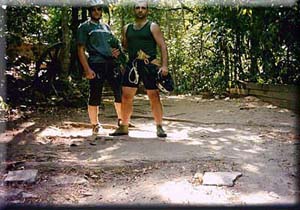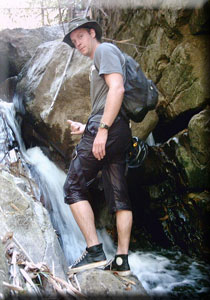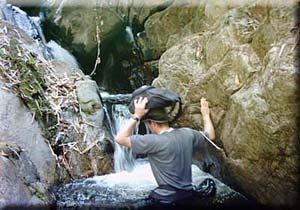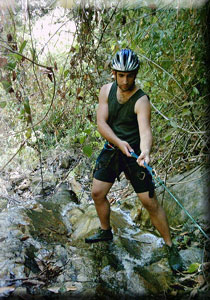Tracing a New River
Doi Saket, Thailand
by Antonio Graceffo
Ask any of today's great adventure writers: Tim Cahill, Paul Theroux, or Robert Young Pelton, and they all agree on one point. "It's been done." Basically everything on this planet which can be done has been. And even more extreme is that with package tour operators making the most remote corners of the globe accessible to everyday people, even formidable obstacles, like climbing The Himalayas are options for the average tourist (more accurately, the average tourist with $60,000, the price of a guided ascent up Everest).
You can't be first to row across the Pacific. A teen-ager has reached the South Pole. Wilfred Thesiger already crossed the Open Quarter of the Sahara, more than once. And my neighbor, Mimo Palmentera, who makes pizza back in Brooklyn, has summated mount Kilimanjaro. So, when that once in a lifetime chance to do something new came my way, I jumped at it.
On one of those sleepy, dull Chiangmai mornings, when you drink a three-in-one coffee and feel you couldn't possibly even look at another elephant ride or bungee jump, I opened my email, and found a message from my good friend, and in this case savior, Kevin Shane Barry, owner of Track of the Tiger Tours, asking me if I would like to go, as part of a two man team, to be the first people ever to trace the river at Doi Saket. I jumped at the chance. Not only would the project renew my interest in life, I had been considering hanging myself just as a change of pace, but it would team me up with Shane's right hand man, Reinier, who had been my adventure partner in an infamous canoe trip on the Maekok River, and who will be accompanying me on an even more infamous trip down the entire Mekong, as soon as we can find someone foolish enough to pay our way.
Although river tracing is a fairly new sport, in Thailand, it has been known for years in Europe and the USA. Most people confuse river tracing with white water rafting, or they at least assume that their is some sort of a boat involved. But they couldn't be further from the truth.
To understand the phenomenon of river tracing is to understand the mechanics of insanity. Everyone has heard the stories about that maniac Captain Webb, who rode over Niagara Falls in a barrel. Outwardly, we say he is crazy. But down deep, doesn't’t plunging down all that white water sound like a good time?
But have you ever considered going up a waterfall?
River tracing, is a new sport, where, not only do you climb up the waterfalls, but you climb up and over every rock and obstacle in the river, tracing it to its source.
Once you have donned your equipment, consisting of a swimsuit, life jacket, helmet, kneepads, rubber boots, and a rappelling harness, it’s time to get wet. The best way to get into a cold river is to simply jump off of a bridge. Your going to get soaked head to toe, anyway, so you might as well just go for it. Taking that first step is a bit counter-intuitive, but like any other controlled fright, it is a rush, and once you hit that ice-cold water, you’ll feel energized.
Reinier and I entered the river during the dry season, so we weren't exactly inundated with water. There was no swimming involved, but the low river presented other problems, as we had to scale, rather than swim over even the smallest stones. Spending long periods of time in the jungle can be a bit depressing because you can see neither the sun nor the sky, because of the canopy of dense foliage over head. Tracing wide rivers has the benefit of being able to see the sky. Tracing a narrow river, like the one at Doi Saket, and running through a typically overgrown Thai jungle, you quickly realize that the river is the only way to go. Attempts to walk beside, or even to get out of, the river will be thwarted by a thick tangle of jungle vines.
In addition to our normal river tracing gear: life vest, helmet, boots, and rappelling harnesses, we also needed to carry machetes. We felt like real Tarzan's as we hacked our way up the river. Every river has it's own personality, and progress is very slow. In most rivers the lack of speed is attributed to the constant force of water impeding your forward movement. But at Doi Saket, the problem was the vegetation, which hung down, from above. We were constantly getting tangled in thorns, vines, and spider webs. And, of course, in Thailand, before grabbing or cutting a vine you want to  make sure that it isn't a man eating snake. The vines themselves can be fairly formidable, as almost every living thing in Thailand is covered with thorns. Gloves would probably have been a good addition to our gear.
make sure that it isn't a man eating snake. The vines themselves can be fairly formidable, as almost every living thing in Thailand is covered with thorns. Gloves would probably have been a good addition to our gear.
The best part of river tracing is climbing up the waterfalls. Clinging to the slippery rocks, making your precarious way, up a vertical slope, with countless gallons of water rushing by you, threatening to tear you off is one of the most exciting activities you could ever engage in. At Doi Saket, however, we came to a huge waterfall, probably over a hundred feet. Since we had no back up team, we decided to play it safe, and hike up the back side of the fall, then climb down, and back up with direct assist (climbing the rope, instead of the rock).
In normal rock climbing, you are only supposed to put your weight on the rock face. The rope is there for safety, not to help you climb. But in river tracing, it is perfectly legal to use the rope to pull yourself up. Reinier and I used a basic climbing technique, called stirrups, where by we first anchored one end of the rope to a tree. Next, we tied loops in the rope, at eight foot intervals, until we ran out of rope. When we finished, we threw the rope over the side.
"I'll go first." I volunteered, as we peered down the cliff. There was a bit of an outcropping which prevented us from seeing the end.
"What if the rope didn't reach the bottom?" Asked Reinier. "We could slip right off the end."
"Good point." I agreed. "You'd better go first."
"You're not scared are you?" asked Reinier.
"At my age I could break a hip." I answered.
In this type of climbing, you use carabineers tied to your rappelling harness, to clip into the loops, working your way down the rope, and back up. Once I saw that Reinier made it back to the top safely, I felt it would
be repetitive for me to complete the climb. So, I went down far enough to make the photos look exciting.
By the time we finished with the water fall, shadows began to grow long. Although we hadn't reached the source of the river, we decided that it might be prudent to turn back. Both being experienced woodsmen, we didn't bother with a compass or a map. Of course this meant that we walked in circles for several hours. But this was OK with me, because I really need to loose weight, and I hate the stair-master at the gym. It's too repetitive.
"Well, we did it!" I said, triumphantly, when we finally reached the car, seconds before the last light would have left the evening sky, sentencing is to spend a very uncomfortable night in the jungle, with no equipment.
"Did what?" Asked Reinier.
"We were the first people to have the opportunity to trace the river at Doi Saket to it's source."
"But we didn't find the source." Said Reinier, dejectedly.
"Yes, but we were the first people to HAVE THE OPPORTUNITY."
When it comes to adventure, I'll take any first I can get.
Contact the author at: antonio_graceffo@hotmail.com
Contact Shane and Reinier at: tiger@chmai.loxinfo.co.th
Copyright © Antonio Graceffo 2004